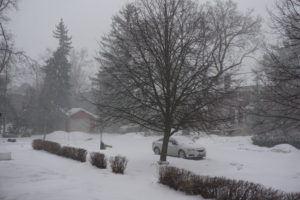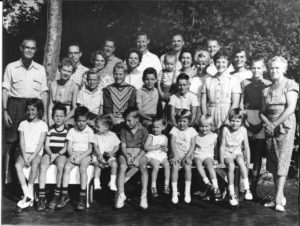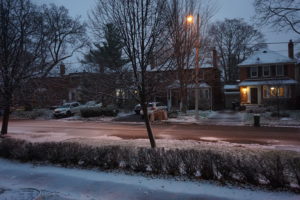February 12: It’s snowing today. This is not really surprising given that we live in Canada and it’s February 12. This is merely the latest in a series of heavy snow storms and deep-freeze events that we have faced this winter. But I am warm and dry. I have enough food to survive a minor apocalypse, and various electronic media with which to reach the outside world should the need arise. My evening class has been cancelled and I have “nothing to do” for the rest of the day.
 That is not to say that I’ll be doing nothing. Rather it is to say that I have no commitments today, and that I am free to do as I wish with my time. No deadlines. No interference.
That is not to say that I’ll be doing nothing. Rather it is to say that I have no commitments today, and that I am free to do as I wish with my time. No deadlines. No interference.
Since I retired, time has become a luxury. It’s a resource that I can allocate any way I wish, on whatever turns my fancy on a given day. It affords the opportunity to explore what I wish, whenever I wish to do so. The problem I face is indolence.
I do not lack for things that interest me. I have been painting in acrylics for at least 15 years and have a huge stack of useless canvas to show for it. I have been pencil sketching off-and-on for some time, and have recently been doing a small bit of exploration in water-colours. I play electric bass for the New Horizon Band which rehearses on Mondays, and I have been trying ( with limited success ) to get in some more frequent running with my buds from the Running Room. All of these things take a certain amount of commitment and practice. Painting and drawing take technical skills and eye-hand co-ordination that has to be nurtured; playing a musical instrument takes practice. Even running requires some element of thoughtful training if it is to be done effectively.
 When a day like today arises it’s not so much about having “nothing to do”, but rather having competing interests to be resolved. I could paint or draw, but that means getting the gear out and finding a place to set up. I need to practice some new pieces for the band, but I hate making mistakes – and practice is all about mistakes – so that’s not really a “fun” way to pass time. It’s too snowy and windy to go running. I have a tendency to postpone actually committing time in favour of doing things to merely pass the time.
When a day like today arises it’s not so much about having “nothing to do”, but rather having competing interests to be resolved. I could paint or draw, but that means getting the gear out and finding a place to set up. I need to practice some new pieces for the band, but I hate making mistakes – and practice is all about mistakes – so that’s not really a “fun” way to pass time. It’s too snowy and windy to go running. I have a tendency to postpone actually committing time in favour of doing things to merely pass the time.
I have an image of myself as creative and active, and yet I do relatively little to actually be that person. When I consider the amount of time that I have available to be creative, it feels wasteful to not be more aggressive in filling it with “worthwhile” effort. While time may be abundant in the short term, it is a finite resource that I don’t want to squander on idleness and indolence. At least for today I can say that I was motivated enough to write 500 words on avoiding indolence.




